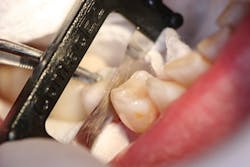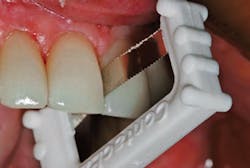The Adjust-Clean-Polish technique uses the ContacEZ Restorative Strip System for complete interproximal finishing with every direct and indirect restoration.
Restorative dentistry is not a practice without its fair share of hurdles, particularly when it's needed in the interproximal spaces, which can be difficult to see and reach. Dentists are faced with a wide variety of challenges that, if improperly addressed, can jeopardize the longevity of the restoration and the patient’s comfort.
To address the most common challenges and provide simple, reliable solutions, ContacEZ has pioneered the Adjust-Clean-Polish technique with its Restorative Strip System. Designed by Dr. Daniel S. Kim after decades of experience in both lab-fabricated and CAD/CAM restorations, the technique utilizes dental strips to adjust proximal contacts, clean out trapped resin cement, and polish the interproximal surfaces to restore a natural finish.
In the first step, Adjust, the proximal contacts are adjusted using the Black Diamond Strip,the Proximal Contact Adjuster (.06-mm, single-sided, fine diamond) (figure 1). In the past, contacts were checked with floss, which could twist or warp, giving unreliable measurements. Contact adjustment was then performed out of the mouth using rotary instruments, leading to inaccurate reduction and, occasionally, crowns being dropped onto the floor. Engineered to precise specifications determined through in-depth clinical trials and research, the Black Diamond Strip is a more accurate and reliable way to adjust proximal contacts directly in the mouth, ensuring relief from tight contacts.
The second step, Clean, concerns the often tricky removal of excess resin cement trapped in interproximal spaces. The White Serrated Strip, the Gentle Saw, (.035-mm, serrated, no diamond)conforms to the contours between the teeth to completely cut and clean out trapped resin cement that neither floss nor scalers can reach (figure 2). The ultra-thin strip can even be inserted between adjacent veneers prior to light-curing without disturbing placement.
In the final step, Polish, the Gray Final Polishing Strip(.05-mm, single-sided, extra-fine diamond)is used to polish off diamond marks and other surface roughness to restore a natural finish (figure 3). This vital step helps reduce the accumulation of bacteria from rough, uneven interproximal surfaces. Using the finest diamond grit of any dental strip on the market, the Gray Final Polishing Stripcan be used without fear of opening the contacts.
To learn more about the Adjust-Clean-Polish technique and the Restorative Strip System, visit contacez.com/how-to-use.
MORE ABOUT CONTACEZ
Joshua Austin, DDS, FAGD, demos interproximal reduction with the ContacEZ IPR Strip System
ContacEZ's Hygienist Strip removes stain from interproximal surfaces
ContacEZ releases Gold Narrow Strip Subgingival Trimmer
Source: ContacEZ press release, 12 May 2016









